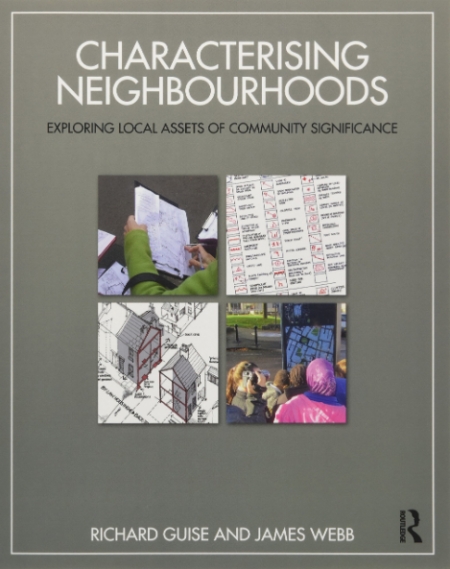Characterising Neighbourhoods: exploring local assets of community significance

|
| Characterising Neighbourhoods: exploring local assets of community significance, Richard Guise and James Webb, Routledge, 2018, 304 pages, fully illustrated, paperback. |
This book deserves to be widely read. Its authors no doubt hoped to come up with a title that would attract the planners, councillors, neighbourhood planning activists, building conservationists, urbanists and students who would benefit from it. Unfortunately, Characterising Neighbourhoods: exploring local assets of community significance is not that title. ‘Characterising’ is a rather clunky term, and it is not clear how ‘exploring local assets of community significance’ relates to it.
What the book does very well is to explain how to assess the character of a place, and how to use that understanding in the planning process. Its strongest feature is the beautiful, annotated drawings by Richard Guise. These communicate brilliantly, and make one regret the thousands of words that other authors write about urban design and conservation without illuminating anything much.
Understanding local character is at the heart of planning, urban design and conservation. If local authorities tell planning applicants one thing about how to develop, it is usually to be responsive to the character of the area. Too often the developer chooses one matter that is in some way locally distinctive – some flint or banded brickwork, perhaps – and uses that to tick the ‘character’ box.
The result is often something that looks ridiculous, all other aspects of the local character having been ignored. In such cases a tokenistic nod to character has been used as an excuse not to think about the complexity of the local context, and to put as little thought as possible into the development’s design.
Because ‘character’ is a simple word, too many people in the built environment professions assume that it must also represent a simple thing. On the contrary, character is shorthand for every aspect of a place considered in its context.
Guise and Webb get to grips with that complexity magnificently. They explain the concept of character and how to use it in neighbourhood planning, urban design and planning decision-making. And they end the book by considering how character can be used in the process of designing development.
A consistent theme is the authors’ belief that many people lack the language to discuss matters of design and spatial planning. They hope that the book’s text, annotated diagrams and captioned illustrations will help to remedy this, and their faith in the book’s effectiveness is surely justified.
They also claim that the map-based notation method that they present ‘provides a common language of characterisation that is available to all’. For those of us who have never used such a notation method, and who wonder if those developed by pioneers such as Gordon Cullen were not just too complicated, we will have to take their word for it. But, whether or not such a notation method is widely usable, the way they discuss their approach to it is, like the rest of this valuable book, highly enlightening.
This article originally appeared as ‘Locally distinctive’ in IHBC's Context 157 (Page 62), published in November 2018. It was written by Rob Cowan, editor of Context.
--Institute of Historic Building Conservation
[edit] Related articles on Designing Buildings Wiki
IHBC NewsBlog
Old Sarum fire in listed (& disputed) WW1 Hangar - Wiltshire Council has sought legal advice after fire engulfed a listed First World War hangar that was embroiled in a lengthy planning dispute.
UK Antarctic Heritage Trust launches ‘Virtual Visit’ website area
The Trust calls on people to 'Immerse yourself in our heritage – Making Antarctica Accessible'
Southend Council pledge to force Kursaal owners to maintain building
The Council has pledged to use ‘every tool in the toolbox’ if urgent repairs are not carried out.
HE’s Research Magazine publishes a major study of the heritage of England’s suburbs
The article traces the long evolution of an internal programme to research 200 years of suburban growth
IHBC Context 183 Wellbeing and Heritage published
The issue explores issues at the intersection of heritage and wellbeing.
SAVE celebrates 50 years of campaigning 1975-2025
SAVE Britain’s Heritage has announced events across the country to celebrate bringing new life to remarkable buildings.
IHBC Annual School 2025 - Shrewsbury 12-14 June
Themed Heritage in Context – Value: Plan: Change, join in-person or online.
200th Anniversary Celebration of the Modern Railway Planned
The Stockton & Darlington Railway opened on September 27, 1825.
Competence Framework Launched for Sustainability in the Built Environment
The Construction Industry Council (CIC) and the Edge have jointly published the framework.
Historic England Launches Wellbeing Strategy for Heritage
Whether through visiting, volunteering, learning or creative practice, engaging with heritage can strengthen confidence, resilience, hope and social connections.















